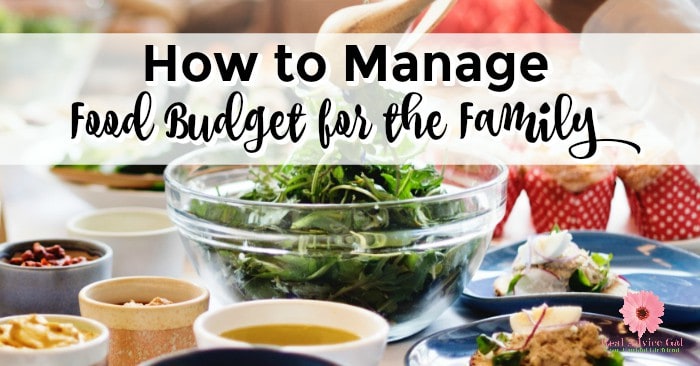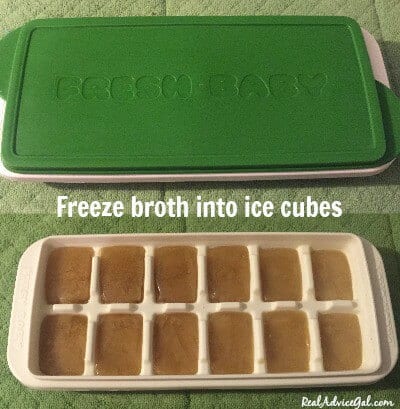How To Budget Plan For Food For A Family

Having a budget plan for your family is a must in all areas. Not just for the major bills you pay monthly. One of the keys to successfully running a household for under $30,000 a year is managing your food budget. The way to make your food budget stretch is to use a few really helpful tips.

How To Budget Plan For Food For A Family

1) Coupons. You may think couponing is hard, or time-consuming, or extreme, but in this day and age with couponing being main stream there is no excuse to great to ignore savings like that. Especially staple items that are regularly in couponing cycles (which are approximately every 6 weeks).

2) Make stocks and seasonings in bulk. When you are cooking food that could be considered simple and uncomplicated, flavor is important. Quinoa is a staple side from most of our dinners. It’s healthy and provides a lot of protein. Throughout the week whenever I use fresh vegetables I tend to keep a little bit of each vegetable and put it into a Ziploc freezer bag. Over the weekend, I boil all of the vegetables in a pot with water and turn it into vegetable stock. I then take the strained liquid and put it into ice cube trays and freeze it into cubes. Those cubes then go into the Ziploc bag. Throughout the week whatever I make quinoa I always throw a cube or two of vegetable stock
Throughout the week whenever I use fresh vegetables I tend to keep a little bit of each vegetable and put it into a Ziploc freezer bag. Over the weekend, I boil all of the vegetables in a pot with water and turn it into vegetable stock. I then take the strained liquid and put it into ice cube trays and freeze it into cubes. Those cubes then go into the Ziploc bag. Throughout the week whatever I make quinoa I always throw a cube or two of vegetable stock into it to flavor it. Another stock that I usually make with leftovers is chicken stock. Sometimes I will buy a rotisserie chicken on the weekend and use it for several dishes during the week. Then I will boil the bones down into chicken stock/bone broth. I also freeze the broth into ice cubes. Fresh herbs also freeze well into ice cubes with water. It is a way to be able to quickly add flavor to many dishes.
3) Don’t skip out on nutritional food. When trying to make food dollars stretch, one of the things that tend to get trimmed out by budget is nutritional value. This is one thing in our budget plan that can’t be an option. Cutting out nutritional value due to budget is never acceptable. Do you know what will cut into your budget? Ill health. An easy and affordable way to add extra nutritional value is to purée vegetables in advance add them into recipes in spoonfuls. If short on time, a way to cut a corner would be to use baby food. I know it sounds crazy, but it is quality food and usually mixes easily into most recipes. Also, soup and salad is a great way to eat healthy on a small budget and keep up with your health. Mason jar salads are easy to prep in advance and crockpot chili can hide a multitude of nutrition.
Having a good budget plan for your groceries is a must. You don’t have to eat only beans and rice when you plan and use all of your food for leftovers, stocks, soups, and other dishes that help you stretch your dollars while giving you healthy nutritious meals.
4. Meal plan and make meals that use a lot of the same ingredients.
5. Buy in bulk. I buy my meat in bulk and then cook it or organize it in freezer meals.
6. Go to the back of your grocery store and look for their sale shelf only buy what is on your list.
7. Learn to look for the cost per ounce of a product. The smallest bottle or box may not be the cheapest.
8. Share large orders with friends. I buy meat in bulk and then split the order with a friend. We both win.
9. Eat before you shop! Drink water while you are shopping. It should help curb your cravings.
10. Use a list. I mean it.

Ultimate List Of Frugal Living Tips
How to Get Out of Debt Problems

Ultimate List Of Frugal Living Tips
Living on 30000 or Less: Raising a Family of 6
Living on 30000 or Less: Raising a Large Family

How to Get Out of Debt Problems

Ultimate List Of Frugal Living Tips
How to Save Up Money: Tips for Living on $30000 or Less
Living on 30000 or Less: Raising a Family of 6
Living on 30000 or Less: Raising a Large Family

How to Get Out of Debt Problems

Ultimate List Of Frugal Living Tips
How to Save Up Money: Tips for Living on $30000 or Less
Living on 30000 or Less: Raising a Family of 6
Living on 30000 or Less: Raising a Large Family

How to Get Out of Debt Problems

Ultimate List Of Frugal Living Tips
Frugal Ways to Save Money: Getting Out of Debts

How to Save Up Money: Tips for Living on $30000 or Less
Living on 30000 or Less: Raising a Family of 6
Living on 30000 or Less: Raising a Large Family

How to Get Out of Debt Problems

Ultimate List Of Frugal Living Tips
How to get rich in 5 minutes a day

Frugal Ways to Save Money: Getting Out of Debts

How to Save Up Money: Tips for Living on $30000 or Less
Living on 30000 or Less: Raising a Family of 6
Living on 30000 or Less: Raising a Large Family

How to Get Out of Debt Problems

Ultimate List Of Frugal Living Tips
How to Use Your Tax Refund to Build Wealth
Angie Rumpf
I am a stay at home mom and happily married to my husband Tom. I have a five year old daughter and a two and a half year old son. I grew up in Orlando, but went to school in New York City and lived in Los Angeles before moving home to raise a family. I have worked in the film industry since the early nineties, and for over a decade with the Florida Film Festival. I also spent many years working in marketing with Glaceau and Honest Tea. But, I am happiest at home building my family.
For more Frugal Tips, read these:

How to get rich in 5 minutes a day

Frugal Ways to Save Money: Getting Out of Debts

How to Save Up Money: Tips for Living on $30000 or Less
Living on 30000 or Less: Raising a Family of 6
Living on 30000 or Less: Raising a Large Family

How to Get Out of Debt Problems

Ultimate List Of Frugal Living Tips
Part 6 – Money Management Skill

Part 7 – Why Couples Should Talk About Money?

How to Use Your Tax Refund to Build Wealth
Angie Rumpf
I am a stay at home mom and happily married to my husband Tom. I have a five year old daughter and a two and a half year old son. I grew up in Orlando, but went to school in New York City and lived in Los Angeles before moving home to raise a family. I have worked in the film industry since the early nineties, and for over a decade with the Florida Film Festival. I also spent many years working in marketing with Glaceau and Honest Tea. But, I am happiest at home building my family.
For more Frugal Tips, read these:

How to get rich in 5 minutes a day

Frugal Ways to Save Money: Getting Out of Debts

How to Save Up Money: Tips for Living on $30000 or Less
Living on 30000 or Less: Raising a Family of 6
Living on 30000 or Less: Raising a Large Family

How to Get Out of Debt Problems

Ultimate List Of Frugal Living Tips
Part 5 – Smart Money Saving Tips to Control Your Debt

Part 6 – Money Management Skill

Part 7 – Why Couples Should Talk About Money?

How to Use Your Tax Refund to Build Wealth
Angie Rumpf
I am a stay at home mom and happily married to my husband Tom. I have a five year old daughter and a two and a half year old son. I grew up in Orlando, but went to school in New York City and lived in Los Angeles before moving home to raise a family. I have worked in the film industry since the early nineties, and for over a decade with the Florida Film Festival. I also spent many years working in marketing with Glaceau and Honest Tea. But, I am happiest at home building my family.
For more Frugal Tips, read these:

How to get rich in 5 minutes a day

Frugal Ways to Save Money: Getting Out of Debts

How to Save Up Money: Tips for Living on $30000 or Less
Living on 30000 or Less: Raising a Family of 6
Living on 30000 or Less: Raising a Large Family

How to Get Out of Debt Problems

Ultimate List Of Frugal Living Tips
Part 4 – How to Not Spend Money

Part 5 – Smart Money Saving Tips to Control Your Debt

Part 6 – Money Management Skill

Part 7 – Why Couples Should Talk About Money?

How to Use Your Tax Refund to Build Wealth
Angie Rumpf
I am a stay at home mom and happily married to my husband Tom. I have a five year old daughter and a two and a half year old son. I grew up in Orlando, but went to school in New York City and lived in Los Angeles before moving home to raise a family. I have worked in the film industry since the early nineties, and for over a decade with the Florida Film Festival. I also spent many years working in marketing with Glaceau and Honest Tea. But, I am happiest at home building my family.
For more Frugal Tips, read these:

How to get rich in 5 minutes a day

Frugal Ways to Save Money: Getting Out of Debts

How to Save Up Money: Tips for Living on $30000 or Less
Living on 30000 or Less: Raising a Family of 6
Living on 30000 or Less: Raising a Large Family

How to Get Out of Debt Problems

Ultimate List Of Frugal Living Tips

Part 2 – Basic Home Budgeting

Part 3 – How to Budget Monthly Finances Wisely

Part 4 – How to Not Spend Money

Part 5 – Smart Money Saving Tips to Control Your Debt

Part 6 – Money Management Skill

Part 7 – Why Couples Should Talk About Money?

How to Use Your Tax Refund to Build Wealth
Angie Rumpf
I am a stay at home mom and happily married to my husband Tom. I have a five year old daughter and a two and a half year old son. I grew up in Orlando, but went to school in New York City and lived in Los Angeles before moving home to raise a family. I have worked in the film industry since the early nineties, and for over a decade with the Florida Film Festival. I also spent many years working in marketing with Glaceau and Honest Tea. But, I am happiest at home building my family.
For more Frugal Tips, read these:

How to get rich in 5 minutes a day

Frugal Ways to Save Money: Getting Out of Debts

How to Save Up Money: Tips for Living on $30000 or Less
Living on 30000 or Less: Raising a Family of 6
Living on 30000 or Less: Raising a Large Family

How to Get Out of Debt Problems

Ultimate List Of Frugal Living Tips
Do you have tips on how to manage food budget for family? Share it with us below.

Part 2 – Basic Home Budgeting

Part 3 – How to Budget Monthly Finances Wisely

Part 4 – How to Not Spend Money

Part 5 – Smart Money Saving Tips to Control Your Debt

Part 6 – Money Management Skill

Part 7 – Why Couples Should Talk About Money?

How to Use Your Tax Refund to Build Wealth
Angie Rumpf
I am a stay at home mom and happily married to my husband Tom. I have a five year old daughter and a two and a half year old son. I grew up in Orlando, but went to school in New York City and lived in Los Angeles before moving home to raise a family. I have worked in the film industry since the early nineties, and for over a decade with the Florida Film Festival. I also spent many years working in marketing with Glaceau and Honest Tea. But, I am happiest at home building my family.
For more Frugal Tips, read these:

How to get rich in 5 minutes a day

Frugal Ways to Save Money: Getting Out of Debts

How to Save Up Money: Tips for Living on $30000 or Less
Living on 30000 or Less: Raising a Family of 6
Living on 30000 or Less: Raising a Large Family

How to Get Out of Debt Problems

Ultimate List Of Frugal Living Tips
Do you have tips on how to manage food budget for family? Share it with us below.

Part 2 – Basic Home Budgeting

Part 3 – How to Budget Monthly Finances Wisely

Part 4 – How to Not Spend Money

Part 5 – Smart Money Saving Tips to Control Your Debt

Part 6 – Money Management Skill

Part 7 – Why Couples Should Talk About Money?

How to Use Your Tax Refund to Build Wealth
Angie Rumpf
I am a stay at home mom and happily married to my husband Tom. I have a five year old daughter and a two and a half year old son. I grew up in Orlando, but went to school in New York City and lived in Los Angeles before moving home to raise a family. I have worked in the film industry since the early nineties, and for over a decade with the Florida Film Festival. I also spent many years working in marketing with Glaceau and Honest Tea. But, I am happiest at home building my family.
For more Frugal Tips, read these:

How to get rich in 5 minutes a day

Frugal Ways to Save Money: Getting Out of Debts

How to Save Up Money: Tips for Living on $30000 or Less
Living on 30000 or Less: Raising a Family of 6
Living on 30000 or Less: Raising a Large Family

How to Get Out of Debt Problems

Ultimate List Of Frugal Living Tips
Do you have tips on how to manage food budget for family? Share it with us below.

Part 2 – Basic Home Budgeting

Part 3 – How to Budget Monthly Finances Wisely

Part 4 – How to Not Spend Money

Part 5 – Smart Money Saving Tips to Control Your Debt

Part 6 – Money Management Skill

Part 7 – Why Couples Should Talk About Money?

How to Use Your Tax Refund to Build Wealth
Angie Rumpf
I am a stay at home mom and happily married to my husband Tom. I have a five year old daughter and a two and a half year old son. I grew up in Orlando, but went to school in New York City and lived in Los Angeles before moving home to raise a family. I have worked in the film industry since the early nineties, and for over a decade with the Florida Film Festival. I also spent many years working in marketing with Glaceau and Honest Tea. But, I am happiest at home building my family.
For more Frugal Tips, read these:

How to get rich in 5 minutes a day

Frugal Ways to Save Money: Getting Out of Debts

How to Save Up Money: Tips for Living on $30000 or Less
Living on 30000 or Less: Raising a Family of 6
Living on 30000 or Less: Raising a Large Family

How to Get Out of Debt Problems

Ultimate List Of Frugal Living Tips
Cook, Baker, Phototaker, Fitness Mover and Shaker, Cupcake Tester, Deal Maker, Adventurous Undertaker, Do Good “Deeder”, Teacher, Mom, Wife, Patriot for Life & Giver of Good Advice – RealAdviceGal





